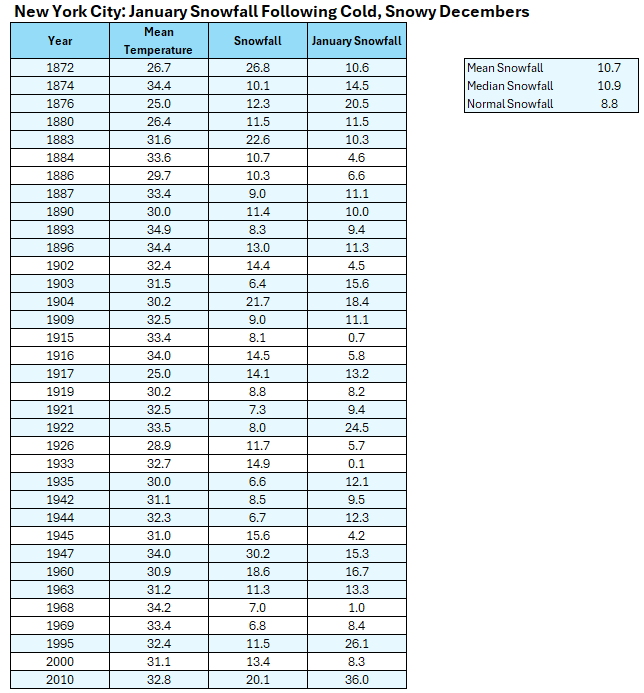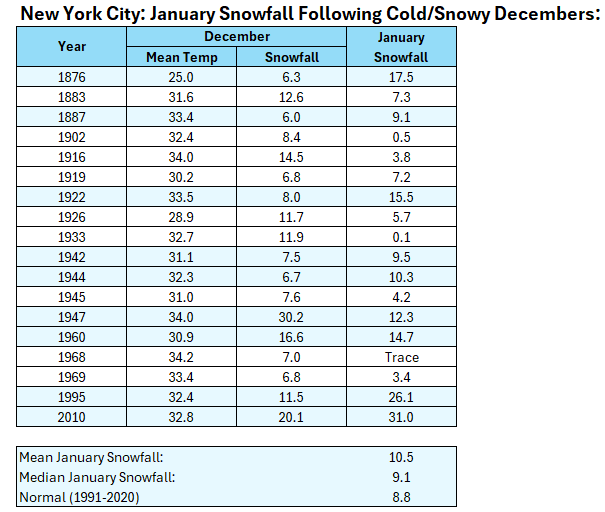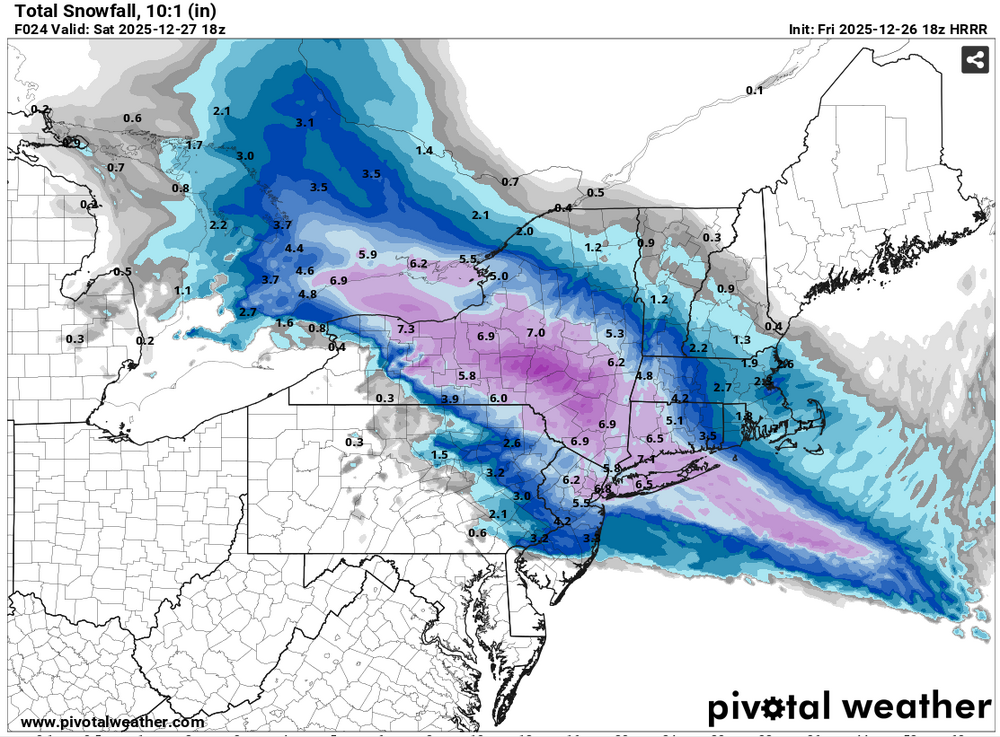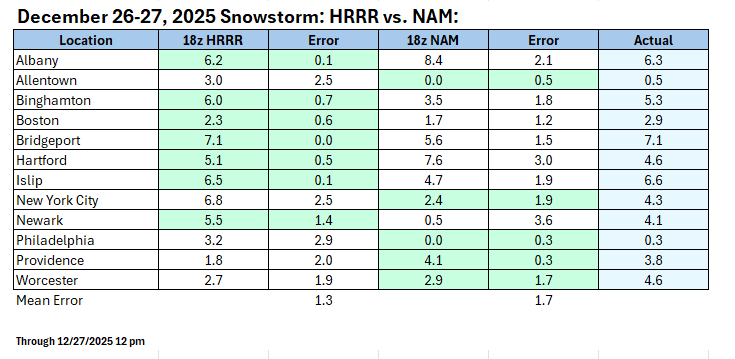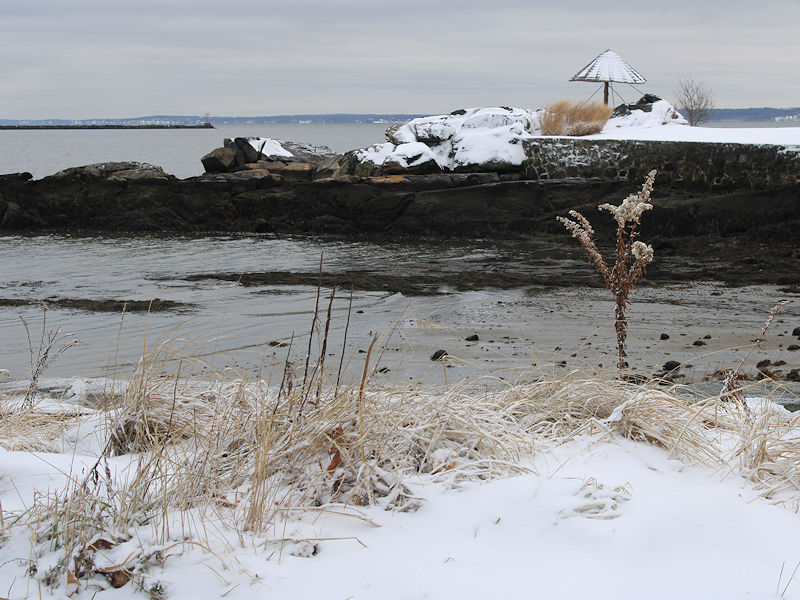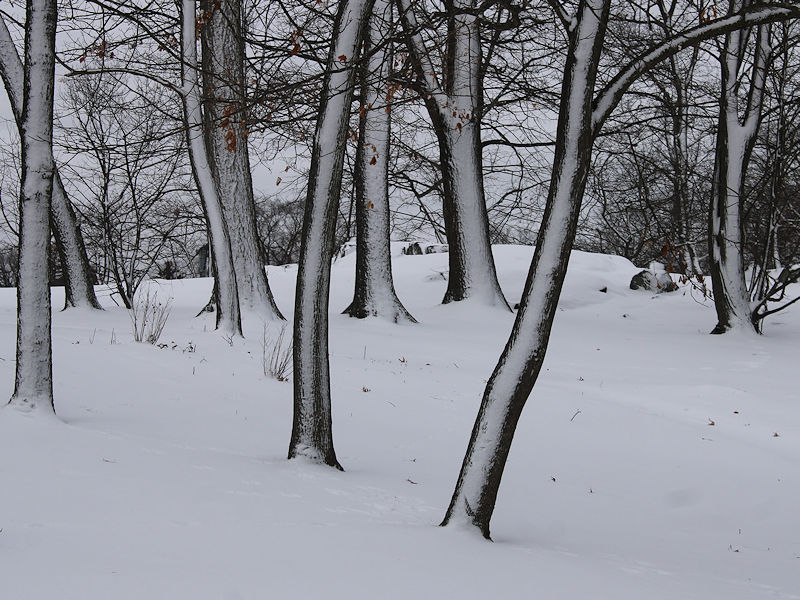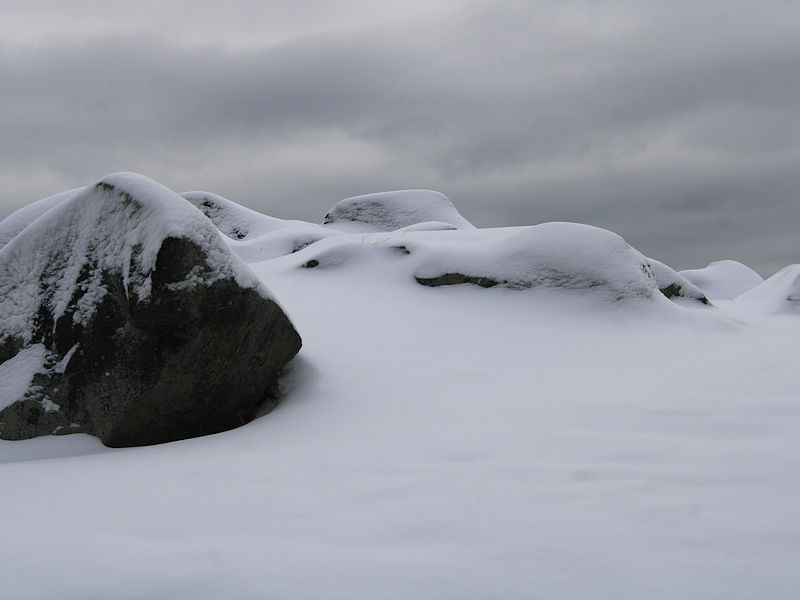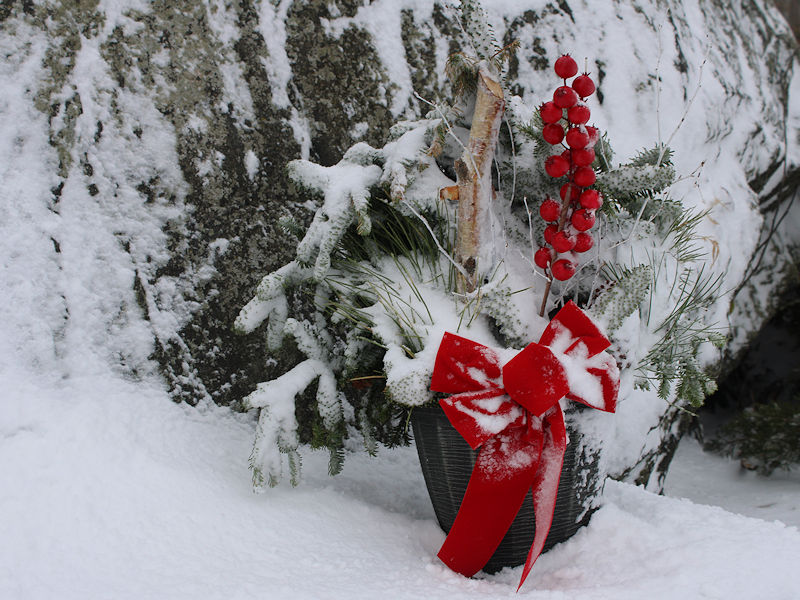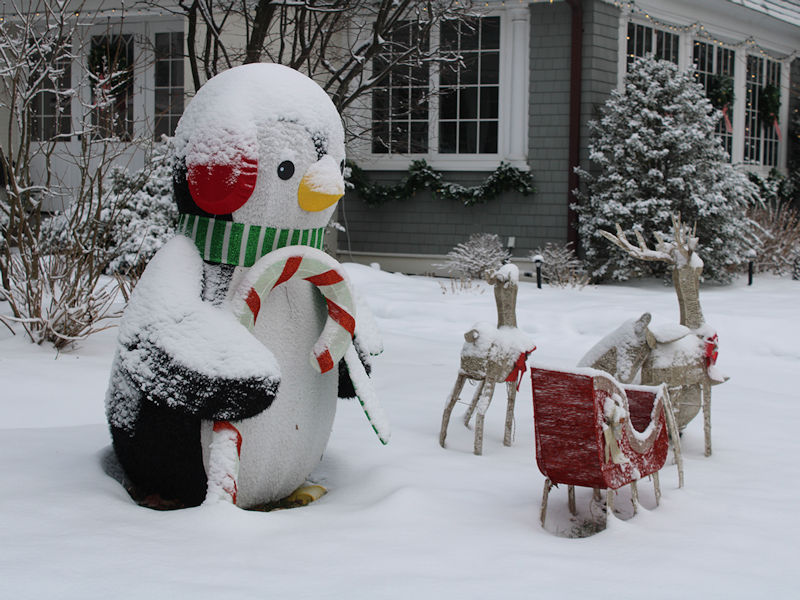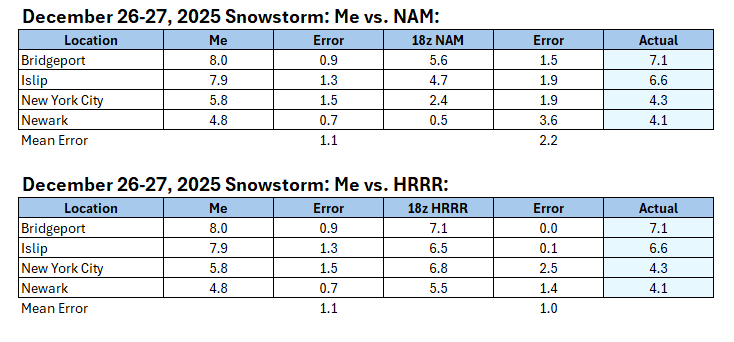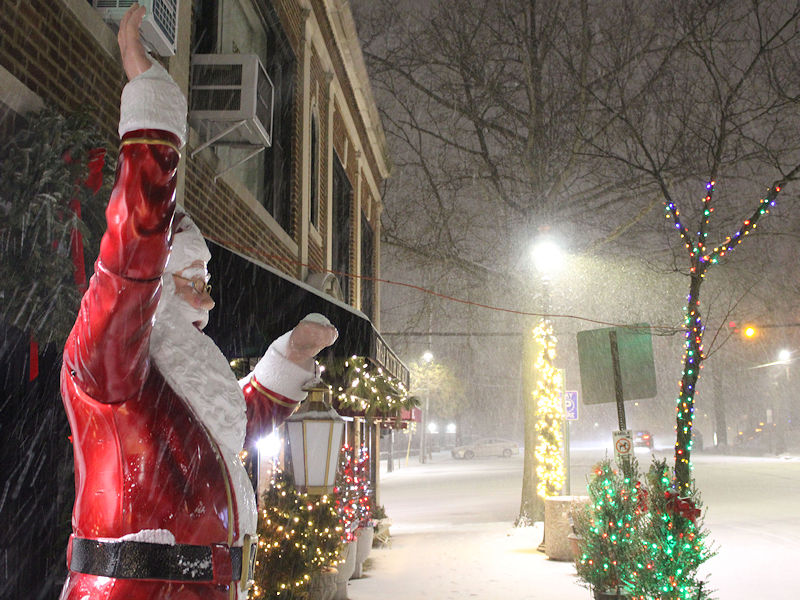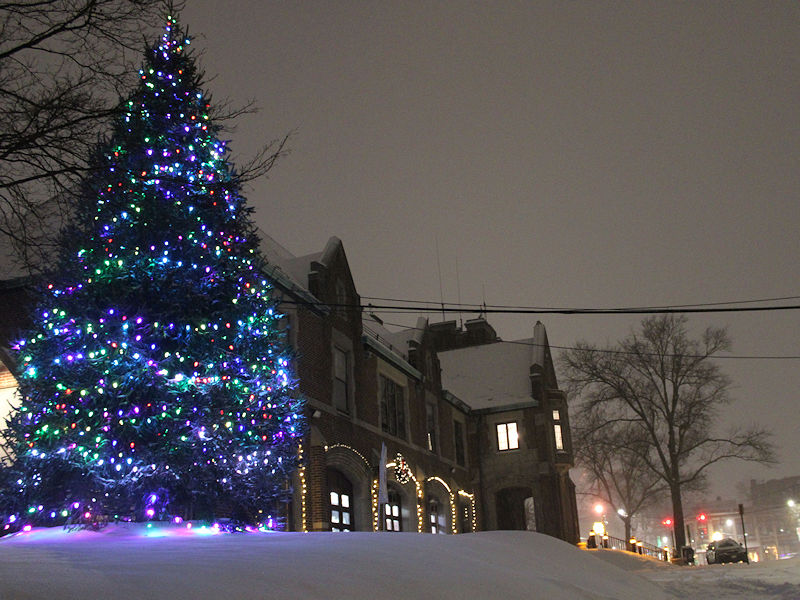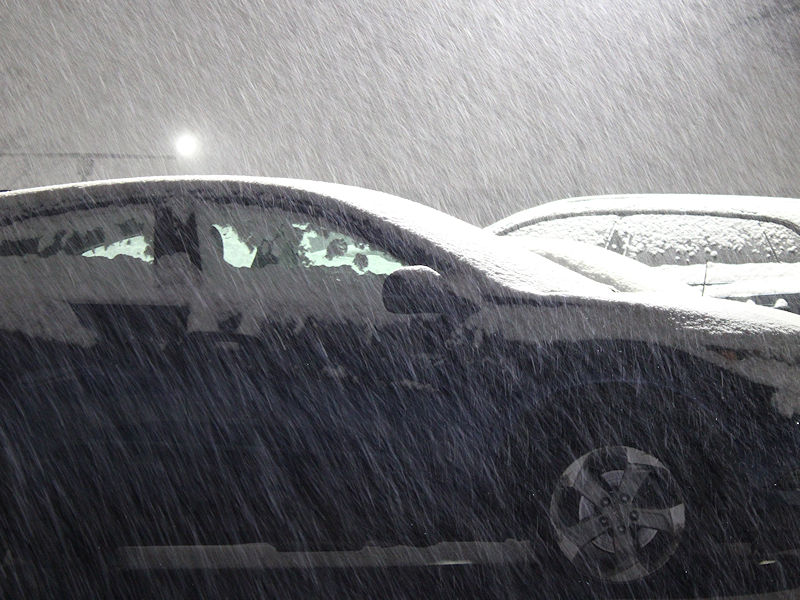-
Posts
23,143 -
Joined
Content Type
Profiles
Blogs
Forums
American Weather
Media Demo
Store
Gallery
Everything posted by donsutherland1
-
New York City's largest snowstorm since January 28-29, 2022 has now departed. Even as precipitation dried up for several hours last evening, Central Park still wound up with 4.3" of snow while JFK Airport, LaGuardia Airport, and Newark all saw 4" or more of snow. Many parts of southwestern Connecticut and Long Island saw 6" or more. Tomorrow will turn somewhat milder as a storm heads for the Great Lakes. Showers and possibly periods of rain will develop late tomorrow and continue into early Monday. The temperature will likely reach the upper 40s to perhaps lower 50s on Monday before colder air moves in behind the departing system. The remainder of December will see cooler than normal days. Below normal temperatures will continue into at least the middle of the first week of January. Some flurries or snow showers are possible late on January 1 into January 2. December 2025 will very likely finish with a maximum monthly temperature below 60° in New York City. The last time that happened was in 2019 when the monthly high was 58°. If 2025 has a monthly high below 60°, that would be only the fifth such occurrence since 2000 (2003, 2004, 2005, and 2019 are the cases since 2000). The ENSO Region 1+2 anomaly was -0.6°C and the Region 3.4 anomaly was -0.8°C for the week centered around December 17. For the past six weeks, the ENSO Region 1+2 anomaly has averaged -0.40°C and the ENSO Region 3.4 anomaly has averaged -0.68°C. La Niña conditions will likely continue through at least mid-winter. The SOI was +14.69 today. The preliminary Arctic Oscillation (AO) was -1.006 today. Based on sensitivity analysis applied to the latest guidance, there is an implied near 100% probability that New York City will have a cooler than normal December (1991-2020 normal). December will likely finish with a mean temperature near 33.9° (5.2° below normal). That will make December 2025 the coldest December since 2010 when the monthly mean temperature was 32.8°. It would also make 2025 the third coldest December since 2000. Supplemental Information: The projected mean would be 3.5° below the 1981-2010 normal monthly value.
-
Against the NWS? I will run them when I get back in this evening. This wasn’t the NWS’s finest forecast.
-
1917 also had a mean temperature of 25.0° for December Corrected Table: Note: The initial table was constructed from summing daily snowfall amounts. Not all daily amounts are in the NYC climate record. Thus, doing so understates the monthly figures. Here's the correct table using the monthly figures.
-
Yes, the La Niña cases were snowier.
-
-
With preliminary PNA values of -1.000 or below both yesterday and today, the snowstorm that just brought 4.3" to Central Park could become New York City's largest December snowfall with PNA values of -1.000 or below for all days during which the snow fell.
-
December 2025 will finish with a mean temperature below 35.0°C (coldest since 2010) and more than 6" of monthly snowfall. Below is how January fared in terms of snowfall following cold and snowy Decembers.
-
As forecasting accuracy requires, among other things, an objective assessment of the guidance, I've expanded the comparison of the 12/26 18z NAM and 12/26 18z HRRR. The major point of contention had been whether the NAM was providing a realistic forecast for the New York City area. It did not fare well. But what over a larger area? Again, the HRRR outperformed the NAM, but its forecasting edge was less decisive. The HRRR was better in assessing where the 4" or above snows would fall from New York City southward. The NAM confined such snows to the north and east of New York City. However, the HRRR was too aggressive in pushing 2"+ snows past Allentown and into Philadelphia. The HRRR also did better in such locations as Albany and Boston. 12/26 18z NAM: 12/26 18z HRRR: Outcomes for 12 Cities:
-
January 29, 2022.
-
The streak without a 4" or above snowstorm ended; the streak with less than 4" daily snowfall continues.
-
I believe it's a good measurement. Every site in Brooklyn, Queens, Manhattan, and the Bronx listed on the NWS PNS had 3" or more. JFK, LGA, and NYC all had somewhat over 4".
-
-
For snowstorms, it's over. Finally. For daily snowfalls, it, unfortunately, continues.
-
18z NAM vs. 18z HRRR: Here's how I fared against the two models: Final Accumulations: Bridgeport: 7.1" Islip: 6.6" New York City-Central Park: 4.3" New York City-JFK Airport: 4.1" New York City-LaGuardia Airport: 4.1" Newark: 4.2" The low end of the 4"-8" idea worked out. The loss of precipitation from the weak lift that developed in the spacing between the surface and mid-level low likely deprived the region of several inches of snow. It also allowed for some intrusion of sleet into the greater New York City area for a time until the lift improved.
-
655 NOUS41 KOKX 271249 PNSOKX CTZ005>012-NJZ002-004-006-103>108-NYZ067>075-078>081-176>179-280049- Public Information Statement National Weather Service New York NY 749 AM EST Sat Dec 27 2025 ...SNOWFALL REPORTS... Location Amount Time/Date Provider ...Connecticut... ...Fairfield County... 4 NNW New Fairfield 9.1 in 0409 AM 12/27 Trained Spotter Bridgeport Airport 7.1 in 0700 AM 12/27 Official NWS Obs 2 ENE New Canaan 7.1 in 0528 AM 12/27 Trained Spotter Bethel 6.5 in 0700 AM 12/27 Emergency Mngr 4 SSE Easton 6.2 in 0600 AM 12/27 Public 1 W Stamford 5.9 in 0605 AM 12/27 Trained Spotter 1 NNW Stamford 5.7 in 0100 AM 12/27 Trained Spotter ...Middlesex County... Clinton 8.0 in 0645 AM 12/27 Broadcast Media 1 SW Westbrook 7.7 in 0240 AM 12/27 Trained Spotter ...New Haven County... 1 NNW Meriden 9.0 in 0350 AM 12/27 Trained Spotter 1 ENE North Haven 7.7 in 1220 AM 12/27 Trained Spotter 2 NW Hamden 7.3 in 0647 AM 12/27 Public 4 SSE Durham 7.1 in 0200 AM 12/27 Public 3 ENE Branford 6.5 in 0647 AM 12/27 Public 3 ENE Branford 6.4 in 1201 AM 12/27 Public 1 NW Ansonia 6.0 in 0531 AM 12/27 Public ...New London County... 5 SSE Salem 7.0 in 0603 AM 12/27 Public New London 6.5 in 1139 PM 12/26 Trained Spotter Ledyard Center 5.5 in 0100 AM 12/27 Trained Spotter ...New Jersey... ...Bergen County... 1 S River Edge 3.3 in 0720 AM 12/27 Public 2 NNE Franklin Lakes 3.2 in 0138 AM 12/27 Public ...Essex County... 2 NE Springfield 3.0 in 0400 AM 12/27 Public 1 NW Newark 2.3 in 1226 AM 12/27 Public ...Hudson County... Harrison 4.0 in 0442 AM 12/27 CO-OP Observer Hoboken 3.9 in 0700 AM 12/27 Trained Spotter ...Union County... Newark Airport 4.2 in 0700 AM 12/27 Official NWS Obs 1 NW Cranford 3.0 in 0717 AM 12/27 Public 1 NE Union 3.0 in 0200 AM 12/27 Public ...New York... ...Bronx County... 1 NNE Fordham 4.3 in 0400 AM 12/27 Public ...Kings County... 1 SSE Williamsburg 4.3 in 0715 AM 12/27 Public 1 N Bay Ridge 3.1 in 0603 AM 12/27 Public ...Nassau County... Massapequa 4.1 in 0700 AM 12/27 Amateur Radio 1 N Centre Island 4.0 in 0529 AM 12/27 Public 1 SW Levittown 4.0 in 0202 AM 12/27 Public Carle Place 3.1 in 0645 AM 12/27 Amateur Radio 1 SW Elmont 2.0 in 1250 AM 12/27 Trained Spotter ...New York (Manhattan) County... Central Park 4.3 in 0700 AM 12/27 Official NWS Obs ...Orange County... 2 SSW Stewart Airport 5.7 in 0724 AM 12/27 Public 2 E Highland Mills 5.2 in 0130 AM 12/27 Public 2 NW Stewart Airport 5.0 in 0628 AM 12/27 Amateur Radio Monroe 5.0 in 0500 AM 12/27 Trained Spotter 2 SSW Stewart Airport 5.0 in 1212 AM 12/27 3 WNW Warwick 4.0 in 0603 AM 12/27 Trained Spotter ...Putnam County... 2 W Putnam Valley 5.7 in 0605 AM 12/27 NWS Employee ...Queens County... 1 WSW Howard Beach 4.6 in 0701 AM 12/27 Broadcast Media NYC/JFK 4.1 in 0700 AM 12/27 Official NWS Obs NYC/La Guardia 4.1 in 0700 AM 12/27 Official NWS Obs ...Suffolk County... Babylon 7.5 in 0645 AM 12/27 Amateur Radio Orient 7.5 in 0615 AM 12/27 Trained Spotter North Patchogue 6.8 in 0109 AM 12/27 Public Islip Airport 6.6 in 0700 AM 12/27 Official NWS Obs Upton (NWS Office) 6.5 in 0700 AM 12/27 Official NWS Obs Stony Brook 5.8 in 0700 AM 12/27 Trained Spotter 1 WNW Sound Beach 5.8 in 0700 AM 12/27 Public 2 E Flanders 5.8 in 1120 PM 12/26 Public 1 SSE Bohemia 5.6 in 0550 AM 12/27 Trained Spotter 2 SE Ridge 5.6 in 1159 PM 12/26 NWS Employee Deer Park 5.3 in 0600 AM 12/27 Trained Spotter 1 WSW Poquott 5.2 in 0425 AM 12/27 NWS Employee Sayville 5.1 in 0700 AM 12/27 NWS Employee 1 ESE East Patchogue 5.1 in 0541 AM 12/27 NWS Employee 1 SSE Bohemia 4.7 in 1205 AM 12/27 Public 2 S Commack 4.5 in 0145 AM 12/27 Public 1 N Smithtown 4.3 in 1200 AM 12/27 Trained Spotter Stony Brook 4.3 in 1155 PM 12/26 Trained Spotter 1 ENE Commack 4.0 in 1140 PM 12/26 Broadcast Media 1 E Kings Park 3.6 in 1259 AM 12/27 Public Medford 3.5 in 0723 AM 12/27 Amateur Radio ...Westchester County... Armonk 6.4 in 0200 AM 12/27 Trained Spotter 2 ENE Peekskill 6.1 in 1200 AM 12/27 Trained Spotter 1 E Pelham Manor 2.8 in 0736 AM 12/27 Public
-
Snow/sleet mixture.
-
At 7 pm. It’s probably around 2”-3”.
-
Light sleet in Larchmont.
-
Thank you, Volcanic Winter.
-
-
-
0.5" in Larchmont, NY.
-
First NAM bust incoming... According to the 12/26 18z NAM (using four algorithms on Bufkit), 1.2"-1.5" of snow was expected at Binghamton before the transition to several hours of sleet. Binghamton has seen snowfall approaching 3.0" as of 5:05 pm with moderate continuing snow to fall.
-
Light-to-moderate snow in Larchmont. The ground is coated.
-
Light snow has reached Larchmont in southern Westchester County.





